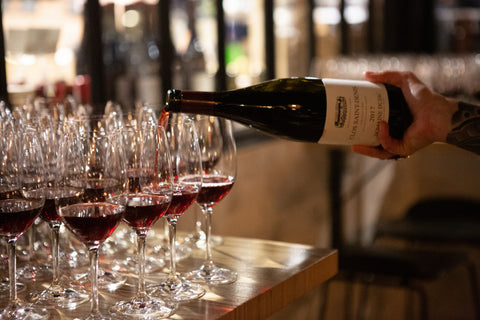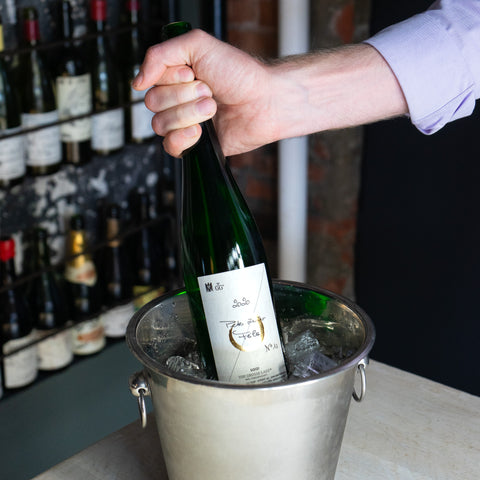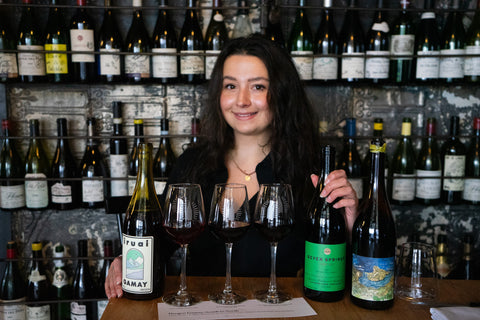A few months ago, I uncorked a 2016 Pinot Noir from Duline in Friuli.
The aromas that exploded out of my glass were miraculously fresh, for all the 7 years on it. Aromas of raspberry and cherry. But the other notes that had developed over those seven years, a symphony of damp earth and dried rose petals and a hint of mushroom, were what kept me coming back.
Experiencing a wine that’s been aged in bottle is a pleasure everybody deserves. And it’s not as difficult or expensive as it’s been made out to be.
I recently spoke to Charlie Gaeta about why somebody might want to start a cellar, the best way to get started, and the regions he’s looking to for amazing values.
If you’re interested in starting your cellar, Charlie can help. Click here to start your collection today.
Dedalus: What are some of the reasons somebody might want to start a cellar?
Charlie Gaeta: I think we all want to drink wines with some age on them. We want to see the vintage and winemakers' vision of how this wine should end up drinking at its highest level. And a lot of the wines that we care deeply about at Dedalus, need some years in bottle and storage before they can really express themselves.
Cellaring is about maximizing the pleasure of a wine you care about. If you’re buying a case instead of 2 or 3 bottles you have the advantage and ability to see how that wine tastes throughout a 3 to 5 to 10 year period. Seeing the progression of a wine is cool.
Dedalus: Before we get into the nerdy stuff, can you tell me about the last bottle-aged wine you had that blew you away?
Charlie: I was traveling in Colorado for my work with Dedalus, and opening up some pretty crazy wines. We opened a bottle of Domaine Dujac Morey St. Denis 1er Cru 2001. Those wines can be very aggressive when they’re young, almost undrinkable. Reductive. And they’re expensive, so it’s heartbreaking in a way because a lot of people open them too young. They’re still delicious, don’t get me wrong, but not hitting their full potential.
Dedalus: What do they taste like when they’re hitting that potential?
Charlie: They start to express more than just the fruit. More than the winemaking techniques. What’s so exciting about drinking bottle-aged wines are the secondary aromas and flavors. How can fermented grape juice smell like earth and mushrooms and rose petals and spice? And those wines, even being Pinot Noir, can have a lot of tannin depending on their vintage. They can be muscular in their youth. You want that bottle age to chill out the tannin to let everything come into balance. Just like growing up.
Dedalus: If someone wants to experience an amazing wine with age on it, and wants to start a cellar, what do they need to get going?
Charlie: You don’t have to break the bank if you’re just starting. You need a space with a consistent cool temperature and low light.
Dedalus: How cool?
Charlie: If you go to a winery or a domaine, how chilly it is there is a good indicator, that’s usually between 52 and 57 degrees. And you don’t have to drop five figures to get that. When I was a young knucklehead living in the city, real estate was slim. Even now, I live in a small studio, so I started bringing wine to my parents’ house to store in their basement. It’s cool and dark and if I’m not planning on drinking the wine anytime soon, it’s fine if it’s not in my apartment.
Dedalus: Once somebody has a space that they can use, what should they start looking for?
Charlie: Collect what you want to drink. But also, if you’re building a cellar of bottles you want to age for 5-10 plus years, whether it’s for enjoyment or as an investment, you want to start with the classics. For white wine, we’re thinking white Burgundy and Riesling from Alsace, Germany, and Austria. For red wines think northern Italy, Barolo, Barbaresco. Then you can look to Tuscany, look for wines like Chianti Classico and Brunello di Montalcino. And in France going back to Burgundy, Northern Rhône Syrah, then Bordeaux, historically is a good investment.
But there are wines from all around the world. I’m seeing some amazing Australian Chardonnay’s and Shiraz’s, Napa Cab made in an old-school style that will age a lot longer than something flashy and new.
Dedalus: Bordeaux, Burgundy, Barolo — for a lot of people starting out, those regions aren’t super accessible. Can you still build a cellar if you don’t have a grand to drop on a case or two?
Charlie: Absolutely. I mentioned northern Italy, and Nebbiolo from Barolo and Barbaresco. But people should also be looking for Valtellina — with climate change, some amazing Nebbiolo is coming out of Alta Piemonte that will age beautifully and cost a lot less than a Barolo.
More wines in the world can age a long time than people are accustomed to thinking about. That’s where sommeliers come in. We’re able to help you find wines you can cellar that won’t break your bank account. With Dedalus, I help connect people to amazing wines that will be in their cellars and on their tables for years to come, and they’re not all as expensive as you might think.
Dedalus: What are some of the other wines you suggest people be on the lookout for, wines that offer amazing return on investment?
Charlie: One of the biggest ROIs for me is Muscadet with bottle age. You can get one of the best producers in the region like Domaine Pepiere for $15 and it’s delicious with oysters as a summer crusher but if you lay it down it can age for 5-10 years. You can get the complexity of a wine that costs way more.
I’d also say, please don’t sleep on Riesling. There’s still a misconception that it’s going to be sweet or sweetness is a bad thing in wine. But Riesling is on the top of the list of age-worthy wines. Riesling has acidity and sugar, both of which help a wine age well.
Germany and Austria are having unbelievable vintage after unbelievable vintage. It used to be every other year you might get a good vintage. Now it’s every year — it keeps getting better and better. The 2021s are the best I’ve ever tasted and a lot of winemakers from those regions agree. And the amazing thing is that, aside from a few culty, allocated producers, you can still buy a case of a blue chip producer from the Mosel or Kamptal for a fraction of what white Burgundy at the same level would be.
If you’re interested in starting your cellar and would like to talk to Charlie about how he can help, click here to get started.



